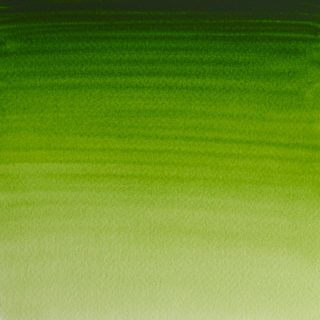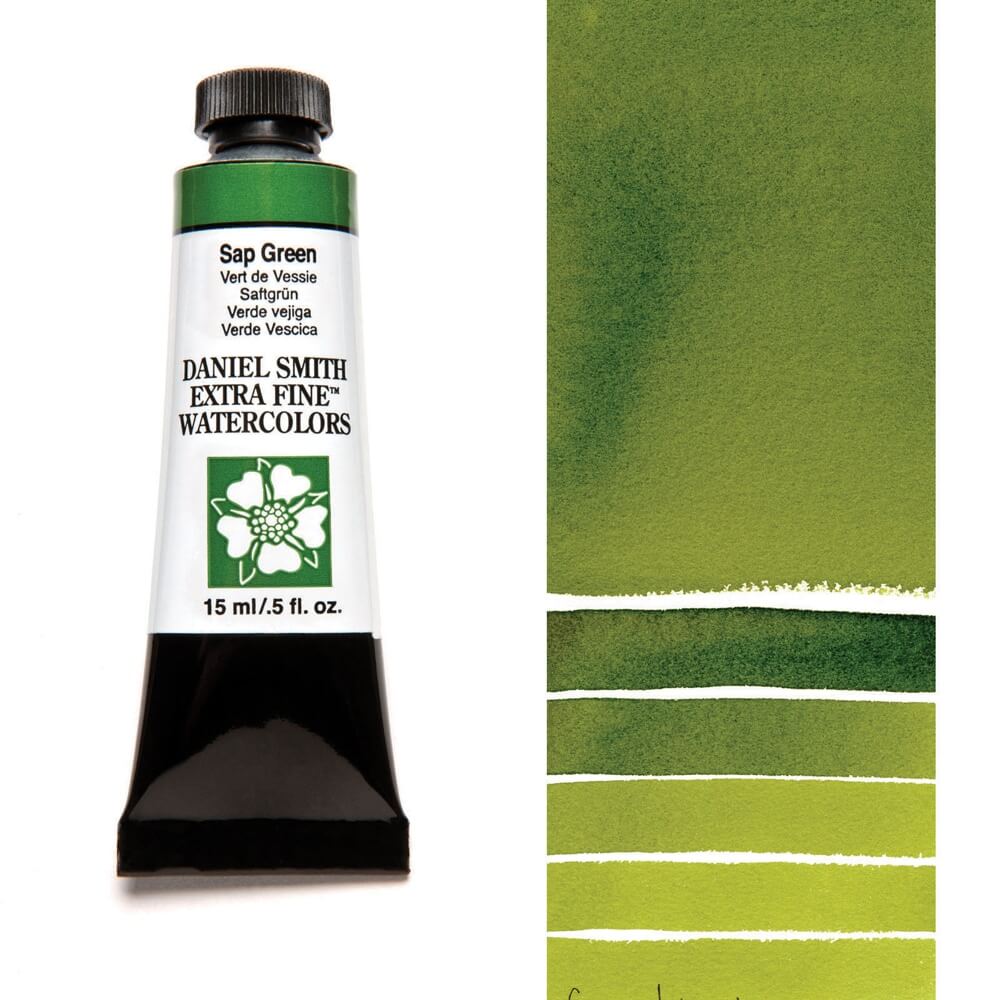For artists, the choice of color is essential in creating a unique and compelling work of art. Every color has its unique characteristics that can evoke different emotions and moods. Permanent Sap Green has found its place in the artist’s palette is versatile and vibrant. In this article, we will explore this color’s use and significance in the art world, providing insights into why it continues to be a popular choice among artists.
Permanent Sap Green by different brands
Find 4 manufacturer(s) of watercolors below. We’ve also compiled a list of our favorite art supplies here.
Permanent Sap Green – Winsor & Newton

Sap Green Permanent is a rich mid-range green with a yellow undertone. Originally Sap Green was a lake pigment made from unripe Buckthorn berries.
| Color No.: 503 | Lightfastness:I – Excellent | Opacity:Transparent |
| Staining: | Granulation:Granulating | Sizes: 5ml tubes; 14ml tubes; Half Pans |
Sap Green – Daniel Smith

DANIEL SMITH’s Sap Green is wonderful – the hue we love with the permanency we need. This non-fugitive formulation creates deep forest shadow-green mixed with French Ultramarine and mossy golden-greens and green-browns when mixed with Burnt Sienna or Quinacridone Sienna or Burnt Orange. Sap Green mixes well with most pigments and leaves a stained residue when lifted. In the French Ultramarine or Quinacridone mixtures mentioned above, squeegee or knife areas to reveal the Sap Green stain and to create blades of spring-shiny grasses within deeper or mossy passages.
| Color No.: | Lightfastness:I – Excellent | Opacity:Transparent |
| Staining:3-Medium Staining | Granulation:Granulating | Sizes: 5ml tubes; 15ml tubes; Sticks; Half Pans |
Sap Green – Van Gogh

| Color No.: 623 | Lightfastness: | Opacity:Transparent |
| Staining: | Granulation: | Sizes: Tube 10 ml |
Sap Green – Rembrandt

| Color No.: 623 | Lightfastness: | Opacity:Transparent |
| Staining: | Granulation: | Sizes: Tube 10 ml |
Tips when choosing colors
When it comes to choosing colors for watercolor painting, there are a few tips to keep in mind. First, consider the color wheel and how different colors interact with each other. Understanding complementary colors, warm and cool tones, and color harmonies can help you create dynamic and visually appealing artworks. Additionally, think about the subject matter and the mood you want to convey. For example, if you are painting a landscape, you may want to choose greens and blues for a calming and natural feel. Lastly, experiment with different brands and pigments to find colors that suit your style and technique. Remember, the color choices you make can greatly impact the overall look and feel of your artwork, so take your time and choose wisely.
Also read, watercolor essentials to see which colors are essential
History of Permanent Sap Green
Permanent Sap Green is a versatile green watercolor paint that is widely used by artists. The color has a rich history that dates back to the 19th century. It was first made by Winsor & Newton in 1862 and was originally called Winsor Green. Later, the color was renamed to Sap Green due to its resemblance to the color of sap in trees. The paint was made by extracting the color from the berries of the buckthorn plant, which was called sap green in the 16th century. Today, the color is made using a mixture of pigments, including phthalo green and yellow ochre, which creates a brighter and more stable version of the original.
How watercolor paint is made
Watercolor paint is typically made from a few simple ingredients:
- pigments
- binders
- water

The pigments used in watercolor paints can be organic or inorganic compounds, such as minerals or synthetic chemicals. These pigments are finely ground and then mixed with a binder, which helps the pigment particles adhere to the paper when the paint is applied.
The most common binder used in watercolor paints is gum arabic, a natural resin extracted from the sap of the acacia tree. Gum arabic is mixed with the pigment to create a thick paste, which is then combined with water to create the final paint.
Other additives may be added to the paint to improve its performance or create specific effects. For example, some watercolor paints may include wetting agents to help the paint spread more evenly on the paper, or preservatives to extend the paint’s shelf life.

Watercolor paints are available in a wide range of colors and textures, from transparent washes to opaque and granulated pigments. Different
manufacturers may use slightly different formulations or ingredients in their paints, which can affect the quality and performance of the paint.
If you’re interested in learning about other colors, check out our pages on Undersea Green, Raw Sienna Light, and Monte Amiata Natural Sienna, which provide in-depth information on these colors and their various shades.
